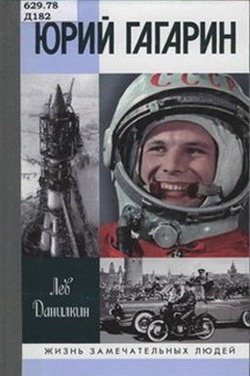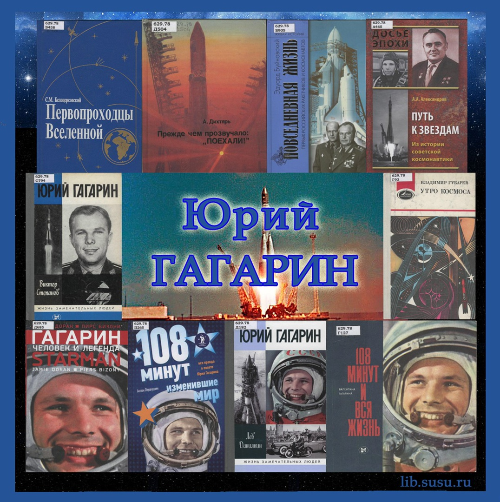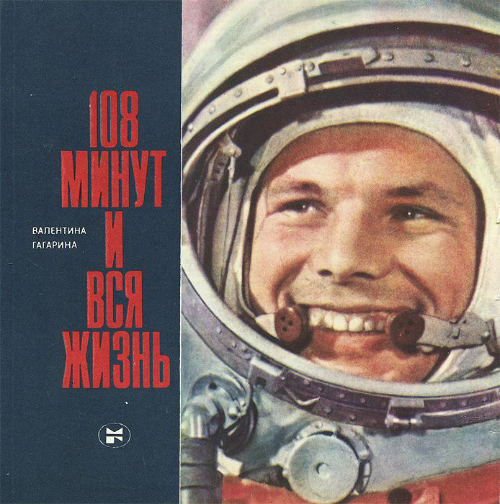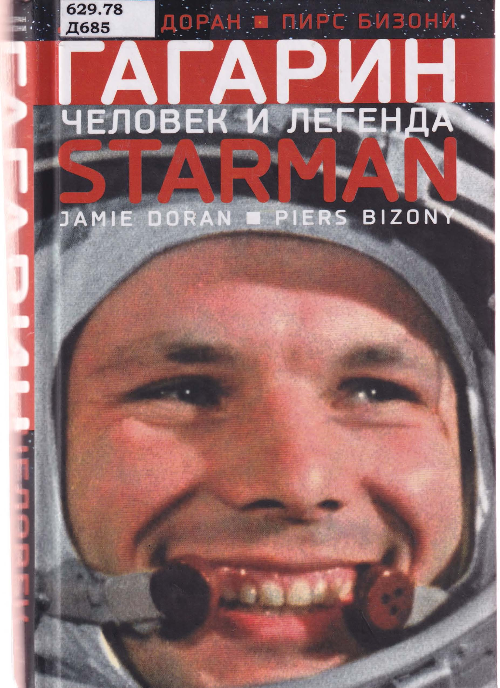Man will not always stay on Earth; the pursuit of light and space will lead him to penetrate the bounds of the atmosphere, timidly at first, but in the end to conquer the whole of solar space.
‑K.E. Tsiolkovsky
April 12th is the Day of Cosmonautics and Aviation, a holiday dedicated to the first human flight into space.
An exhibition "Pathway to the Stars. From the Calculations by Tsiolkovsky to the Space Flight of Gagarin" has opened in the Catalogue Room of the SUSU Scientific Library (Room 203, University Building 3Д) on the occasion of the Day of Cosmonautics and Aviation.
Sixty years ago, on April 12, 1961, the Soviet cosmonaut Yuri Gagarin completed the first Earth orbital flight. The flight which lasted only 108 minutes became a breakthrough in space exploration. The name of Yuri Gagarin became well known all around the world, and the first cosmonaut himself was merit-promoted to Major and awarded the Title of Hero of the Soviet Union.
Below is a description of several books about Yuri Gagarin, about cosmonautics and space exploration.
.png)
The book Selected Works on Rocket Engineering by the founding father of cosmonautics Konstantin Tsiolkovsky includes the major works by Tsiolkovsky on rocket engineering, as well as certain works in aviation directly related to flights of rocket aircraft.
In the works by Tsiolkovsky you will find proposals to use jet exhaust from aircraft engines, projects of powerful semi-rocket engines for airplanes, project of an air rocket engine for stratosphere flights, sketches of rocket-propelled aircraft to exit the atmosphere, ideas on designing interplanetary stations, and finally, speculations of the future colossal settlements somewhere on the asteroids. He discussed all these topics not just using his imagination, but based them on scientific facts.

According to the surveys, Yuri Gagarin is considered to be the main hero of the Russian history in the 20th century. The book Yuri Gagarin by Lev Danilkin is an attempt of an "ultimate", if it is at all possible, biography of the "Red Icarus" that would fill all the gaps in it; this is the currently most complete life chronicle, as well as a comprehension of what the myth about Gagarin is and what the idea of "Gagarin" is. Interviews with eyewitnesses and a total revision of the Russian and foreign sources helped the author to answer the basic questions. Is Gagarin just an embodiment of the Soviet design, or did he truly have certain unique qualities? What did actually happen on April 12, 1961? How did the first cosmonaut cope with the craze about Gagarin – in his status of the most famous person on the planet? What is Gagarin: a product of the political system and epoch, or a mirror reflecting and justifying it? Did he have a conflict with the political leaders of the USSR? What was the real cause of his death? Was his success mere luck, or a result of conscious organization of his life, or the fulfilment of some grand design? What would have become of Gagarin and the USSR had the "first citizen of the Universe" not died in March of 1968 and lived in our time? The book is devoted to the 50th anniversary of the first flight into space.
The next book covers the period from 1944 till 1971 and describes the first steps in the Russian cosmonautics.

Pathway to the Stars. Excerpts on the History of the Soviet Cosmonautics by A.A. Alexandrov. From the book by Anatoly Alexandrov, who for many years has worked in the rocket industry, you will learn about the creators of unique space apparatus, hero cosmonauts and ordinary workers of the missile corps, who participated in the space exploration and the creation of the missile shield of our Motherland.

Pioneers of the Universe: Earth – Cosmos – Earth by S.M. Belotserkovsky.
The author of the book, Sergei Belotserkovsky, was a Soviet scientist in the field of rocket and space engineering, Doctor of Sciences (Engineering), Professor, supervisor of the engineering training of the corps of the first Soviet cosmonauts, Lieutenant General in aviation. He was also the academic advisor for the diploma thesis of Yuri Gagarin, and a member of the committee which investigated the cause of the plane crash in 1968 that took the lives of Yuri Gagarin and Vladimir Seryogin.
Sergei Belotserkovsky shares on the life and activities by Yuri Gagarin and the first cosmonauts, about the relationships within the corps and around it, about the studies at Zhukovsky Air Force Engineering Academy, and their pathway to science.
Much attention is paid to the analysis of the situation, in which the Russian cosmonautics emerged and developed, and also, the book describes the triumph and the tragedy of Korolev and Gagarin, and the formation of the space-oriented world view.

The book Everyday Life of the First Missile Specialists and Cosmonauts (Living History: Everyday Life of Humanity) by Eduard Buynovsky, who was a member of the second coprs of cosmonauts, reveals little-known facts about the daily work, successes and failures, about the feelings and worries, joys and frustrations. Humour, sophisticated irony, playful remarks, and comments about certain events will help you easily figure out the profoundly technical terms and definitions, the more so since there was always a place for humour and jokes in the meticulous and difficult everyday life of the first Russian missile specialists and cosmonauts.

The album-book 108 Minutes and the Whole Life by the wife of the first cosmonaut Valentina Gagarina narrates about Yuri Gagarin, the first human being to cross the edge of the unknown cosmos, about his life and love, recognition and ideals. This is a book about the hard pathway through the space, about the 108 minutes of the space flight, and about what happened after that...

In their book Starman: The Truth Behind the Legend of Yuri Gagarin Jamie Doran, a BBC producer, and Piers Bizony, a famous scientific journalist, describe how the Soviet space project was born. The pages of this book bring to life the images of the brilliant design engineers, members of the first corps of cosmonauts, and many other outstanding people who stood at the origins of the Soviet cosmonautics. The authors narrate about the attitude to the successes of the Soviet Union back in the early 1960s on behalf of the international community and, first and foremost, the USA, our major competitors in space exploration. While working on their book, Doran and Bizony used a lot of monographies, archive materials and personal accounts of eyewitnesses of those events. Based on this book, the well-known Starman film was shot by the BBC.

The gift-book 7 Space Victories and 42 Other Events in Russian Cosmonautics that You Must Know About compiled by Ekaterina Beloglazova is an encyclopaedia of the history of the Russian cosmonautics describing both the main discoveries by the Russian researchers, and the lesser-known facts, which will be interesting to all those fascinated by the topic of human beings in space. All the articles are illustrated by the archive photos, many of which have been published for the first time.
The book narrates about 7 crucial victories of the Russian cosmonautics, which Russia is proud of: Tsiolkovsky as the founding father of cosmonautics; the space flight by Gagarin, the first lunar rover, the first satellites (sputniks), the first spacewalk, Mir orbital space station, and GLONASS. Also, the book provides information about 42 other significant steps made by the Russian researchers and cosmonauts on their path towards conquering the space.
The album-book Remember When Cadet Gagarin Walked the Streets of Our Town…compiled by the citizen of Orenburg Vyacheslav Ryabov is dedicated to the life of the first cosmonaut of planet Earth Yuri Gagarin, the first person in the history of the humanity to complete a manned mission to the near-Earth space on April 12, 1961. Many pages in this book are given to the materials and photos from the period when Yuri Gagarin lived in Orenburg: his studies in the Air Force military school, and his visits to Orenburg. The book is released on the occasion of the 50th anniversary of the first flight into space.
Touches to the Portrait of Russian Cosmonautics compiled by Tatiana Golovkina is another book on the topic of the development of cosmonautics.
The documents cover the period from 1941 through 2017. The collected papers present a documented pathway taken by the Russian rocket engineering and cosmonautics, from the first salvo fire of the Katyusha multiple rocket launchers, to the prospects of flying to other planets.
Opening this book you immerse into the atmosphere of resounding victories and failures, hard space routine, battles of ideas and opinions – all that is inherent in the history of the Russian cosmonautics.
The documents will tell you about at what high price came the victory in the Great Patriotic War, which became a preface for our space victories, as well as about how the V-2 rocket was assembled literally from shards, how the first Soviet ballistic missiles were tested, and how the first artificial satellite of the Earth was created.
You will learn why cosmonaut Gherman Titov nearly died during one of the trainings, what special words the chief designer Sergei Korolev said to cosmonaut Alexei Leonov right before his spacewalk, and how our cosmonautics survived at the turn of the century.
These books are intended for the readers passionate about the history of the Russian cosmonautics.
All these books you may find in the Fund Management Department of the SUSU Scientific Library (Catalogue Room, University Building 3Д), in the Reading Room of Natural Sciences, Technical and Economics Literature (403, Reading Room, University Building 3Д), and at the Delivery Desk of Natural Sciences and Technical Literature (semi-basement floor, Delivery Desk of Natural Sciences and Technical Literature, Main University Building).




